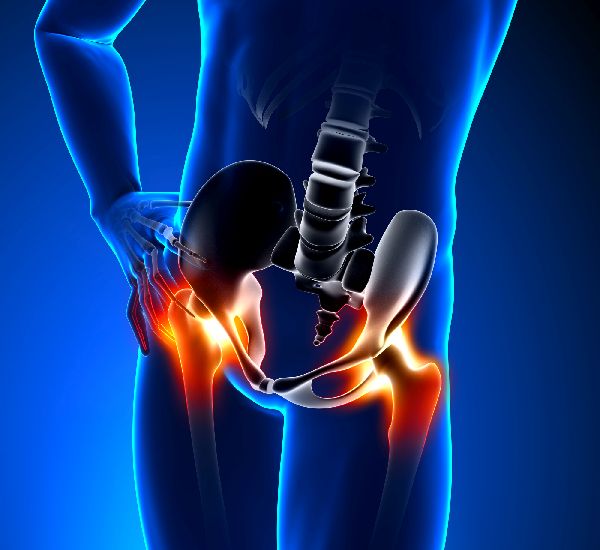Unlocking Hip Health: Causes and Solutions for Your Hip Pain
Hip pain is a common complaint that can stem from many different causes, ranging from overuse, to sports injury, or chronic conditions. Understanding the sources of hip pain can help you choose the best approach for managing and relieving it.
Here’s an overview of the typical causes of hip pain and some conservative treatment options that may help.
Common Sources of Hip Pain
- Arthritis: Osteoarthritis is one of the most common causes of hip pain, particularly in people over 50. This wear-and-tear condition occurs when the protective cartilage covering the joint surface wears down, leading to stiffness, pain, and reduced range of motion. Rheumatoid arthritis, an autoimmune disease, can also cause hip pain and inflammation.
- Bursitis: Bursae are small, fluid-filled sacs that reduce friction between tissues. When the bursa in the hip becomes inflamed (often due to repetitive activities), it can lead to a painful condition known as bursitis. Hip bursitis pain is often sharp and located on the outside of the hip.
- Tendonitis: Tendons connect muscles to bones, and overuse or sudden increases in activity can lead to tendon inflammation, known as tendonitis. Hip flexor and gluteal tendinitis are common causes of hip pain, especially in athletes or those who frequently engage in running or cycling.
- Labral Tears: The hip joint contains a ring of cartilage called the labrum that helps cushion the joint and maintain its stability. Tears in the labrum can occur due to trauma, overuse, or structural issues in the hip. Labral tears can cause sharp, catching pain, especially with certain movements.
- Hip Impingement (FAI): Femoroacetabular impingement (FAI) occurs when extra bone growth around the hip joint causes abnormal contact between the pelvis and hip bones. This condition can lead to pain during activities that involve deep bending of the hip, and may eventually contribute to cartilage damage.
Conservative Approaches to Managing Hip Pain
If you’re experiencing hip pain, there are several conservative, non-surgical approaches to try before considering more invasive options. Here are some effective methods to help alleviate hip pain:
- Rest and Activity Modification: Resting the hip joint and avoiding activities that aggravate the pain can help give the hip time to heal. Switching to low-impact exercises, like swimming or cycling, can reduce joint stress while keeping you active.
- Structural Chiropractic: a Structural Chiropractor can help you restore proper anatomical structure (i.e. your internal “architecture”), so that optimal structure can allow for optimal function. Just like a Formula One or NASCAR race car has to get “tuned up” every X number of laps, a human body performs and functions better with better structure.
- Physical Therapy: A physical therapist can help identify muscular imbalances or movement issues that may be contributing to hip pain. They can prescribe targeted exercises to improve hip strength, flexibility, and stability. For example, strengthening the glutes and core muscles can provide support to the hip joint and reduce pain.
- Stretching Exercises: Gentle stretching of the hip flexors, glutes, and hamstrings can improve flexibility and alleviate tightness in the hip area. Stretches like the figure-four stretch, hip flexor stretch, and pigeon pose can help relieve discomfort. CLICK HERE FOR A HIP OPTIMIZATION EXERCISE PROGRAM.
- Anti-inflammatory Medications: Over-the-counter nonsteroidal anti-inflammatory drugs (NSAIDs), such as ibuprofen, can reduce pain and inflammation in the hip. Be sure to follow dosing guidelines and consult a medical doctor if you have concerns about using these medications.
- Ice and Heat Therapy: Applying ice to the affected area can help reduce inflammation, especially after physical activity. In contrast, heat therapy can help soothe stiff muscles around the hip joint. Alternating between ice and heat may provide balanced relief.
- Lifestyle Modification & Weight Loss: Maintaining a healthy weight can help reduce the load on the hip joint, minimizing pain and delaying the progression of conditions like osteoarthritis. Regular low-impact exercise, a balanced diet, and proper posture can also contribute to hip health.
- Regenerative Medicine: newer alternatives such as PRP (platelet-rich plasma) and stem cell injections can be alternative options for more severe cases of hip pain.
Initially, your doctor will typically do a physical examination and take x-rays, and in some cases, send you out for an MRI to diagnose the exact source of pain.
If you need more information on what the best option is for your hip pain, call us at 714 540 6792 to set up a no-charge consultation with us, or click here to book your own appointment.

